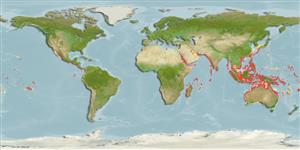>
Eupercaria/misc (Various families in series Eupercaria) >
Labridae (Wrasses) > Corinae
Etymology: Halichoeres: Greek, als, alis = salt + Greek, choiros = pig (Ref. 45335).
More on author: Bennett.
Environment: milieu / climate zone / depth range / distribution range
Ekologi
laut berasosiasi dengan karang; kisaran kedalaman 10 - 40 m (Ref. 90102). Tropical
Indo-West Pacific: Persian Gulf (Ref.80050); Red Sea and the Gulf to Samoa, north to southern Japan, south to the Great Barrier Reef (Ref. 9710). Western Indian Ocean: Mozambique (Ref. 41878).
Size / Weight / umur
Maturity: Lm ? range ? - ? cm
Max length : 20.0 cm TL jantan/; (Ref. 9710)
deskripsi pendek
Kunci identifiaksi (pengenalan) | Morfologi | Morfometrik
Duri punggung (Keseluruhan (total)) : 9; duri punggung lunak (Keseluruhan (total)) : 11; Duri dubur: 3; Sirip dubur lunak: 11. Females light bluish gray dorsally, white ventrally, with a narrow orange stripe running from the top of the snout to the upper base of the caudal fin (where it may contain a blackish spot). Males blue-green on head and anterior portions of the body with irregular pink band and spots; their orange-yellow lateral stripe blue-edged, often with narrow extensions; a blue-edged spot at the upper portion of the pectoral fin base, and two or more similar blue-edged spots just anterior of the caudal peduncle above the lateral stripe.
Inhabits open sand and rubble areas of seaward reefs, to depths greater than 34 m (Ref. 9710). Usually in small groups of females with single males patrolling the area (Ref. 48636).
Life cycle and mating behavior
Kematangan | Reproduksi, perkembang biakan | Pemijahan | telur-telur | Fecundity | Larva
Distinct pairing during breeding (Ref. 205).
Randall, J.E., G.R. Allen and R.C. Steene, 1990. Fishes of the Great Barrier Reef and Coral Sea. University of Hawaii Press, Honolulu, Hawaii. 506 p. (Ref. 2334)
Status IUCN Red List (Ref. 130435: Version 2024-1)
ancaman kepada manusia
Harmless
penggunaan manusia
Perikanan: komersial; Akuarium: Komersial
Alat, peralatan
laporan khas
muat turun XML
Sumber internet
Estimates based on models
Preferred temperature (Ref.
123201): 24.6 - 29.1, mean 27.9 °C (based on 750 cells).
Phylogenetic diversity index (Ref.
82804): PD
50 = 0.5000 [Uniqueness, from 0.5 = low to 2.0 = high].
Bayesian length-weight: a=0.00977 (0.00569 - 0.01680), b=3.15 (3.00 - 3.30), in cm total length, based on LWR estimates for this species & Genus-body shape (Ref.
93245).
Trophic level (Ref.
69278): 3.5 ±0.5 se; based on size and trophs of closest relatives
Daya lenting (Ref.
120179): sedang, Waktu penggandaan populasi minimum 1.4 - 4.4 tahun (Preliminary K or Fecundity.).
Fishing Vulnerability (Ref.
59153): Low vulnerability (10 of 100).
Nutrients (Ref.
124155): Calcium = 70.5 [42.3, 114.2] mg/100g; Iron = 0.663 [0.394, 1.202] mg/100g; Protein = 18.5 [15.6, 20.6] %; Omega3 = 0.153 [0.101, 0.231] g/100g; Selenium = 26 [16, 45] μg/100g; VitaminA = 130 [41, 463] μg/100g; Zinc = 1.59 [1.11, 2.48] mg/100g (wet weight);
